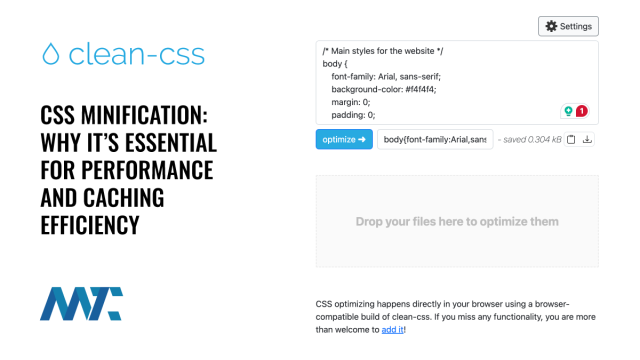CSS minification is a crucial optimization process that enhances website performance by reducing file size without altering functionality. By removing unnecessary characters, spaces, and redundant code, minification significantly improves load speeds, enhances browser caching efficiency, and optimizes bandwidth consumption. This article will explore the necessity of CSS minification, its role in browser caching, and a deep dive into the various bloat factors and optimization levels within the Clean-CSS GitHub script.
Table of Contents
Why CSS Minification Is Necessary and ImportantPerformance GainsBrowser Caching and Long-Term BenefitsReduced Bandwidth CostsWhat Drives CSS Bloat?Level 0 OptimizationsLevel 1 OptimizationsLevel 2 OptimizationsOutput Formatting and ReadabilityBefore CSS MinificationAfter CSS Minification
Why CSS Minification Is Necessary and Important
Performance Gains
Minifying CSS leads to smaller file sizes, allowing browsers to download and process stylesheets quickly. Since CSS files are render-blocking resources, a delay in their loading can cause page render delays. By reducing CSS file sizes, websites render faster, improving user experience and search engine ranking.
Browser Caching and Long-Term Benefits
One often-overlooked advantage of minification is its role in browser caching. When a browser loads a website, it stores assets, including CSS files, in its cache. The next time a user visits the site, the browser retrieves the cached CSS instead of downloading it again. Because minified CSS files are smaller, they require less bandwidth, improving the first page load and performance on subsequent visits.
Reduced Bandwidth Costs
Minifying CSS files decreases the amount of data transferred between the server and client, reducing bandwidth consumption. This is particularly beneficial for mobile users and websites with heavy traffic, leading to cost savings on data transfer and improved browsing speed.
What Drives CSS Bloat?
CSS bloat results from unnecessary characters, redundant properties, inefficient selectors, and outdated styles. The Clean-CSS GitHub script provides a structured CSS minification approach with various optimization levels.
Level 0 Optimizations
Level 0 optimization is the baseline minification process, primarily removing whitespace, comments, and redundant semicolons. While effective for reducing file size, deeper optimizations are required to eliminate redundant CSS properties.
Level 1 Optimizations
At this level, Clean-CSS introduces additional cleanup procedures to optimize basic CSS properties and remove inefficiencies:
Cleanup @charset At-Rules: Ensures that charset declarations are consistent and positioned correctly at the top of the CSS file.
Normalize URLs: Converts relative URLs to absolute paths when applicable, optimizing asset loading.
Optimize Background Properties: Merges redundant background properties into shorthand notation.
Optimize Border-Radius Properties: Simplifies border-radius values when possible.
Optimize Filter / -ms-filter Properties: Ensures cross-browser compatibility for CSS filters by optimizing syntax.
Optimize Font-Weight Properties: Converts font-weight values into their numerical equivalents where applicable (e.g., bold → 700).
Optimize Outline Properties: Merges redundant outline properties into shorthand format.
Remove Empty Rules and Nested Blocks: Eliminates CSS rules that contain no styles, reducing unnecessary weight.
Remove Negative Paddings: Prevents invalid padding values that could cause rendering issues.
Remove Quotes: Eliminates unnecessary quotes around font-family names when not required.
Remove Whitespace: Strips excess whitespace, reducing file size.
Replace Multiple Zeros: Converts 0.0 values to 0 where applicable.
Replace Time Units: Converts unnecessary time units, such as 0s → 0.
Replace 0 Units: Removes units from zero values (e.g., 0px → 0).
Unit Rounding Precision: Rounds numeric values to reduce file size while maintaining precision (e.g., 5px → 4px if configured).
Selector Sorting Method: Standard
Clean-CSS utilizes a standard selector sorting method, ensuring CSS rules are ordered for optimal efficiency. Properly sorted selectors improve maintainability and prevent redundant style declarations.
Special Comments Handling
Keep All Special Comments: Retains important comments (such as license or author attributions) while stripping unnecessary ones.
Additional Cleanup and Organization
Beyond compression, Clean-CSS ensures that stylesheets are well-structured for maintainability:
Tidy @rules: Ensures @import, @media, and other at-rules are formatted properly.
Tidy Block Scopes: Ensures that nested styles follow a logical and efficient order.
Tidy Selectors: Cleans up selector formatting, improving consistency across stylesheets.
Level 2 Optimizations
Level 2 optimizations introduce aggressive minification techniques, including:
Merging Duplicate Rules: Consolidates multiple identical selectors to remove redundancy.
Further Property Merging: Identifies and combines related properties to use shorthand notation where possible.
Restructuring for Efficiency: Analyzes rule order to improve efficiency and minimize duplication.
Ensuring Modern Browser Compatibility
Modern browsers, including Internet Explorer 11+, support minified CSS without rendering issues. Clean-CSS optimizations maintain compatibility with the latest web standards, ensuring a seamless experience across all major browsers.
Output Formatting and Readability
While minification reduces file size, it may impact developers’ readability. Clean-CSS provides formatting options to ensure that minified CSS remains structured for debugging and maintenance purposes.
Before CSS Minification
/* Main styles for the website */
body {
font-family: Arial, sans-serif;
background-color: #f4f4f4;
margin: 0;
padding: 0;
}
/* Header styles */
header {
background: #333;
color: #fff;
text-align: center;
padding: 20px;
}
/* Navigation styles */
nav {
display: flex;
justify-content: center;
background: #444;
padding: 10px;
}
nav a {
color: white;
text-decoration: none;
padding: 10px 15px;
margin: 0 5px;
}
nav a:hover {
background: #555;
}
/* Content styles */
.container {
width: 80%;
margin: auto;
padding: 20px;
background: #fff;
}
/* Footer */
footer {
text-align: center;
padding: 10px;
background: #222;
color: #ccc;
margin-top: 20px;
}
After CSS Minification
body{font-family:Arial,sans-serif;background-color:#f4f4f4;margin:0;padding:0}header{background:#333;color:#fff;text-align:center;padding:20px}nav{display:flex;justify-content:center;background:#444;padding:10px}nav a{color:#fff;text-decoration:none;padding:10px 15px;margin:0 5px}nav a:hover{background:#555}.container{width:80%;margin:auto;padding:20px;background:#fff}footer{text-align:center;padding:10px;background:#222;color:#ccc;margin-top:20px}
This example’s original CSS file size was 756 bytes, while the minified version is 452 bytes. This results in a savings of 304 bytes, a 40.21% reduction in file size.
CSS minification is a critical performance optimization that benefits both first-time and returning visitors by reducing file sizes and enhancing browser caching efficiency. The Clean-CSS GitHub script provides a comprehensive approach to removing CSS bloat through various optimization levels, ensuring cleaner, faster, and more efficient stylesheets.
By adopting CSS minification, developers can significantly improve website performance, enhance SEO rankings, and reduce bandwidth costs—resulting in a faster, more optimized web experience.
©2025 DK New Media, LLC, All rights reserved | Disclosure
Originally Published on Martech Zone: CSS Minification: Why It’s Essential for Performance and Caching Efficiency

